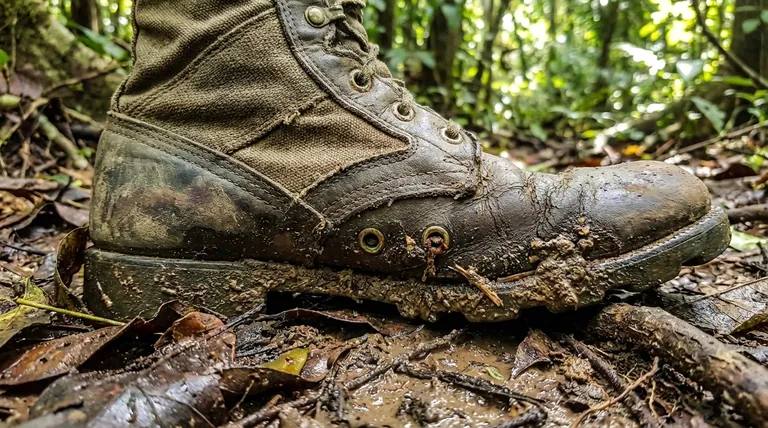The fundamental issue with outdated drain holes in jungle boots was their design, which used bulky, high-profile strainers made from inferior materials. This construction led directly to faster material degradation, frequent clogging from debris, and ultimately, a severely reduced ability to drain water from the boot.
The core problem wasn't just the presence of drain holes, but their flawed engineering. An ineffective drainage system traps moisture, which compromises foot health, increases boot weight, and undermines the entire purpose of the design.

The Flaw in Older Jungle Boot Designs
Jungle boots were conceived to operate in wet, humid environments where keeping feet dry is impossible. The design philosophy is not to prevent water from getting in, but to let it escape as quickly as possible. Outdated designs failed this primary mission due to specific component issues.
The Strainer: A Point of Failure
The "strainer" is the mesh or screen over the drain hole that prevents sand, mud, and debris from entering the boot while letting water out. In older models, this was a critical vulnerability.
Older strainers were bulky and high-profile, meaning they protruded significantly. This made them susceptible to snagging on terrain and damage from external impacts.
Material Degradation: The Hidden Weakness
The materials used in these older strainers were often not robust enough for prolonged exposure to harsh jungle conditions.
Constant moisture, mud, and friction caused these materials to degrade and break down much faster than the rest of the boot. A broken strainer is an open invitation for debris to enter the boot, creating friction points that lead to blisters and sores.
Understanding the Trade-offs
The goal of a jungle boot's drainage system seems simple, but its execution involves a delicate balance. The design must be effective without introducing new problems.
Clogging vs. Debris Entry
An effective drain hole must have a strainer fine enough to block sand and pebbles but open enough to avoid becoming clogged with mud and silt.
Outdated designs often failed this test. Their strainers would quickly become packed with mud, rendering the drainage system useless and trapping water inside the boot. This trapped water adds significant weight and accelerates skin breakdown.
Durability vs. Drainage Speed
The components must be durable, but adding heavy, reinforced materials can make the boot less comfortable and potentially slow down drainage.
The use of poor, less durable materials in older drain holes was a failed compromise. It resulted in a system that was neither effective at draining nor capable of withstanding the operational environment.
How to Apply This to Your Footwear Choice
Understanding these historical design flaws helps you evaluate modern tactical or outdoor footwear more effectively.
- If your primary focus is wet environments: Look for boots with low-profile, integrated drainage ports made from corrosion-resistant materials like stainless steel or durable polymer.
- If your primary focus is durability: Ensure the drainage components are recessed or protected to prevent them from being snagged or damaged by rocks and roots.
- If your primary focus is foot health: Prioritize a boot with a proven, non-clogging drainage system, as trapped moisture is the greatest threat to your feet in the field.
Ultimately, an effective drainage system is a critical feature that works silently to keep you mobile and mission-ready.
Summary Table:
| Issue with Outdated Drain Holes | Consequence |
|---|---|
| Bulky, High-Profile Strainers | Susceptible to snagging and damage |
| Inferior Material Quality | Faster degradation and breakdown |
| Poor Strainer Design | Frequent clogging with mud and debris |
| Ineffective Water Drainage | Trapped moisture, increased weight, skin breakdown |
Don't let poor drainage compromise performance. As a large-scale manufacturer, 3515 produces a comprehensive range of high-performance footwear for distributors, brand owners, and bulk clients. Our advanced production capabilities ensure durable, well-engineered boots with effective drainage systems designed for the toughest conditions.
Let us help you equip your team with reliable footwear. Contact 3515 today to discuss your manufacturing needs and discover how our expertise can benefit your business.
Visual Guide

Related Products
- Custom OEM Training Shoes Wholesale Manufacturer Durable & Breathable
- Safety Footwear Wholesale Manufacturer for Custom OEM/ODM Production
- Durable Rubber Sole Outdoor Shoes Wholesale & Custom Manufacturing
- Wholesale Safety Footwear Manufacturer for Bulk & Custom OEM Orders
- Premium Wholesale Waterproof Safety Boots High Performance Protection for Industrial Markets
People Also Ask
- What are the features of non-slip athletic sneakers? The Ultimate Guide to Traction & Performance
- What industries benefit from safety trainers? Lightweight Protection for Modern Workplaces
- Which type of footwear is better suited for prolonged use in tough environments? Choose Durable Boots for Maximum Safety & Comfort
- What is Athlete's Foot, and how does it spread? Prevent Contagious Fungal Infections
- What are the characteristics of strap-closure work shoes? Speed, Convenience, and Key Trade-offs



















